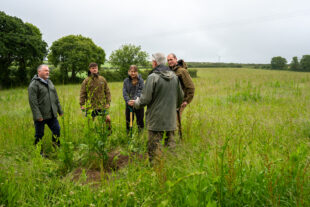https://defrafarming.blog.gov.uk/manage-rushes-in-grassland/
Manage rushes in grassland
The guidance on this page is for SFI pilot participants only. Please visit GOV.UK for the official Sustainable Farming Incentive scheme guidance.
Find out how land managers can maintain grassland habitat condition and support ground nesting wading birds.
If you’re completing this action as part of the Sustainable Farming Incentive pilot, how you do it is up to you.
The advice on this page can help you get better environmental and business benefits, but you do not have to follow it to get paid.
About rush management
Rushes occur naturally in low-input and species-rich grassland. These include:
- purple moor grass and rush pasture
- lowland meadows, particularly on floodplains
- upland hay meadows
There are many different types of rush, which add variety and structure to grasslands. Rushes give wading birds secure nesting sites and cover from predators. Breeding waders will use open and wet areas between rushes to find food.
Species of non-jointed rushes, like soft and hard rush, form in tussocks. If tussocks become too dense and you see a high increase of rushes, you may need to manage them. They can:
- prevent the growth of other vegetation
- reduce the grazing value of your field
You do not need to manage jointed rushes, like blunt-flowered and sharp-flowered rush. They have less impact on grassland as they do not form in dense tussocks.
To identify jointed rushes, you can pinch a leaf firmly between your fingers and pull it through. They will feel bumpy due to the air pockets inside.
Benefits of well managed rushes
By managing rushes you’ll:
- maintain the grazing value of your fields
- see an improved hay yield
- provide important breeding sites and shelter for threatened wading birds
- identify and resolve issues with soil or water management
- increase access to and beauty of the landscape as features become more visible
Rush cover
Rushes should grow in small, scattered clumps. These should be open with grass growing through the middle.
Ideal rush cover will vary in different types of species-rich grassland. As a guide, in:
- purple moor grass and rush pastures, rush cover can reach up to 50%
- damp species-rich meadows, rush cover may be up to 25%
- most other species-rich grassland, rush cover should be less than 10%
Fields should have up to 30% rush cover where the aim is to:
- manage upland pastures for breeding waders
- manage lowland wet grassland for breeding waders
Identify rush management problems
Problems with rushes often mean there’s an underlying issue with soil or grazing management.
Soil condition
Rush cover can become a problem on grassland prone to wet soils, like meadows in the uplands and on floodplains. In these situations, you may need to maintain existing drainage structures if they have been neglected.
Livestock levels
Maintain species rich grassland to keep an even sward with little bare ground. This will reduce the impact of rushes on grassland in the long term.
Excessive livestock levels can cause poaching and waterlogged conditions, particularly on clay-rich soils. Manage your livestock levels to prevent the spread of rushes, as they will colonise bare and wet ground.
Where rushes are already established, under grazing can cause an increase in cover.
Find out how to manage livestock for habitat conservation in species-rich grassland.
Before you start rush management
Avoid rush management on permanently wet areas of fields like springs and flushes, or where bog mosses grow. Management is not likely to work and you can damage other plants in these locations.
Birds, nests and eggs are protected by law. You must check the field before you cut. If you see signs of nesting birds, delay cutting until birds fledge. The best time is normally mid-August.
How to manage rushes
You should cut rushes or combine cutting with aftermath grazing.
Cut them close to the ground at least once a year to reduce vigour. You can graze before cutting to reduce the amount of cut material, unless the field is a hay meadow.
You need to take one cut before rushes set seed. Make sure this is after ground nesting birds have fledged.
You can use a tractor-pulled grass mower to cut rushes. On dense growth you can use a:
- pasture topper
- flail
- forage harvester
You can use cut material for bedding.
If there is regrowth during autumn, you can cut a second time before the end of the growing season if the field is not too wet.
Alternatively, use livestock to graze regrowth and keep it at less than 20cm. Livestock prefer younger regrowth. Cattle are usually best, as sheep may not graze rush.
Avoid creating bare ground as this can increase rush growth.
Herbicide use
Where cutting and grazing does not control problem rushes, you can use precision pesticide application. This includes spot spraying and weed wiping. Weed wiping is best used on younger regrowth.
Use herbicides where:
- rush growth is dense or covers large areas of the field
- the aim is to provide good conditions for wading birds
Do not use herbicide on species-rich grassland as it affects non-target species.



